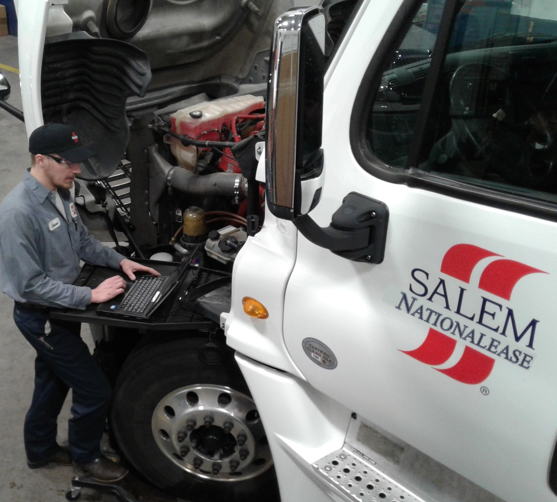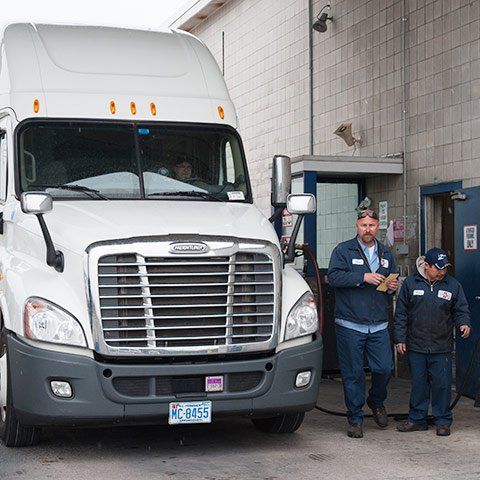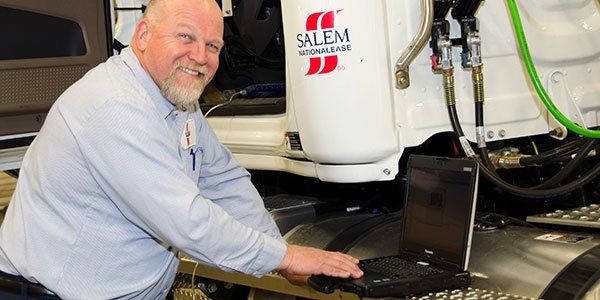Mechanics & Technicians
Job Description
- Examine vehicles to determine extent of damage or malfunctions.
- Test drive vehicles, and test components and systems, using equipment such as infrared engine analyzers, compression gauges, and computerized diagnostic devices.
- Repair, reline, replace, and adjust brakes.
- Review work orders and discuss work with supervisors.
- Follow checklists to ensure all important parts are examined, including belts, hoses, steering systems, brake and fuel systems, wheel bearings, and other potentially troublesome areas.
- Plan work procedures, using charts, technical manuals, and experience.
- Test and adjust repaired systems to meet manufacturers’ performance specifications.
- Communicate with driver to obtain descriptions of vehicle problems. Verify problems by checking the DVIR and sign off on repairs when completed.
- Perform routine and scheduled maintenance services such as oil changes, lubrications, and tune-ups.
- Repair and service air conditioning, heating, engine-cooling, and electrical systems.
- Repair or replace parts such as pistons, rods, gears, valves, and bearings.
- Tear down, repair, and rebuild faulty assemblies such as power systems, steering systems, and linkages.
- Rewire ignition systems, lights, and instrument panels.
- Repair radiator leaks.
- Install and repair accessories such as radios, heaters, mirrors, and windshield wipers.
- Repair manual and automatic transmissions.
- Repair or replace shock absorbers.
- Replace and adjust headlights.
- Complies with all safety, DOT and OSHA guidelines.
- Ensure cleanliness of shop and surrounding areas.
Physical Abilities & Demands
- Stand (Constantly)
- Walk (Constantly)
- Sit (Occasionally)
- Handling / Fingering (Constantly)
- Reach Outward (Constantly)
- Reach Above Shoulder (Constantly)
- Climb (Frequently)
- Crawl (Occasionally)
- Squat or Kneel (Frequently)
- Bend (Frequently)
- Lift /Carry
- 21-50 lbs. (Frequently)
- 51-100 lbs. (Occasionally)
- Over 100 lbs. (Occasionally)
- Push / Pull
- 26-40 lbs. (Occasionally)
- 41-100 lbs. (Frequently)
Occasionally – Requires this activity up to 33% of the time (0 – 2.5+ hrs./day)
Frequently – Requires this activity from 33% – 66% of the time (2.5 – 5.5+ hrs./day)
Constantly – Requires this activity more than 66% of the time (5.5+ hrs./day)
Other Physical Requirements
Vision
Near, Distance, Color, Peripheral, Depth Perception
Sense of Sound
Must hear forced whisper voice>5 ft. with or without hearing aid.
Sense of Touch
Be able to detect your environment, including temperature, humidity, and air pressure; feel physical pain–a necessity for avoiding injury, disease, and danger.
Protective Equipment
Ability to wear Personal Protective Equipment (PPE) (Safety Glasses, Steel Toe Shoes, Back Braces and Protective Clothing.






